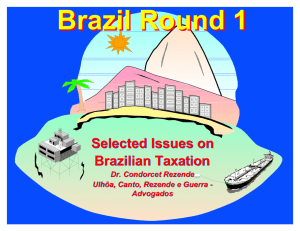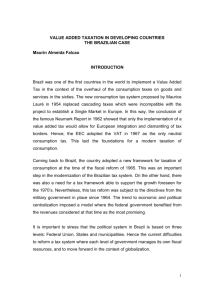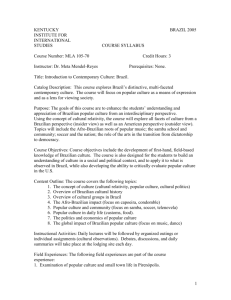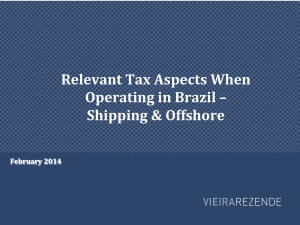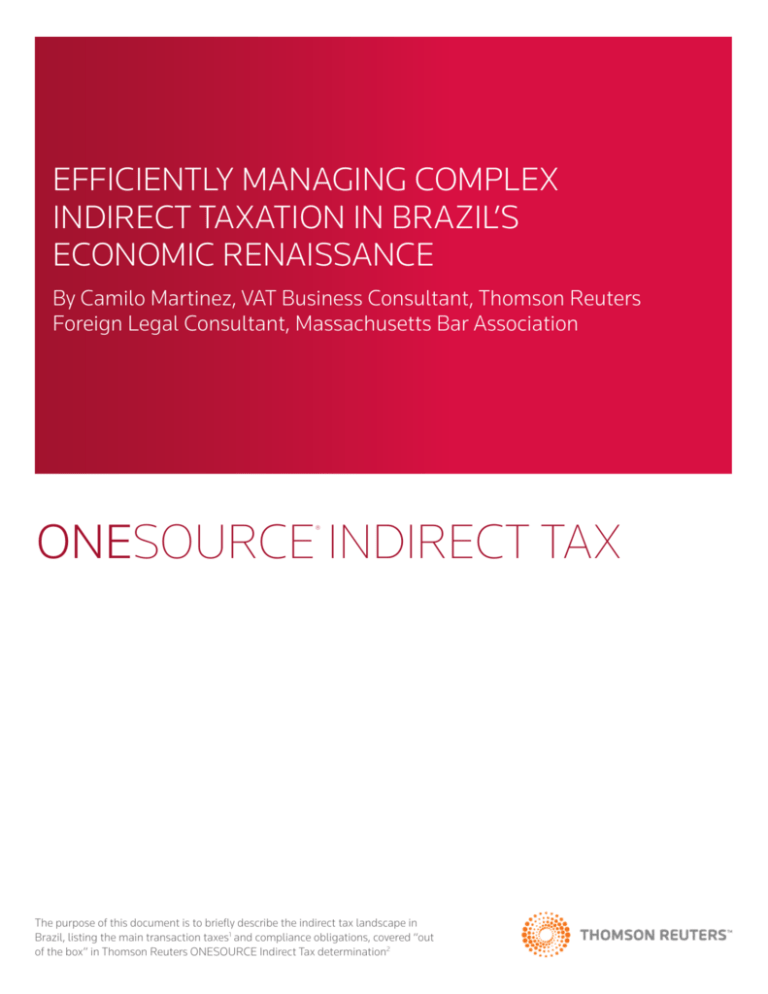
EFFICIENTLY MANAGING COMPLEX
INDIRECT TAXATION IN BRAZIL’S
ECONOMIC RENAISSANCE
By Camilo Martinez, VAT Business Consultant, Thomson Reuters
Foreign Legal Consultant, Massachusetts Bar Association
ONESOURCE INDIRECT TAX
®
The purpose of this document is to briefly describe the indirect tax landscape in
Brazil, listing the main transaction taxes1 and compliance obligations, covered “out
of the box” in Thomson Reuters ONESOURCE Indirect Tax determination2
EFFICIENTLY MANAGING COMPLEX INDIRECT
TAXATION IN BRAZIL’S ECONOMIC RENAISSANCE
BACKGROUND
In the wake of Brazil’s economic renaissance, U.S.-headquartered companies have rediscovered the country.
Now the sixth largest economy in the world and the first Latin American country to bounce back from the global
economic crisis, Brazil presents unique challenges for foreign corporations.
These corporations must learn how to navigate what is arguably the most complex taxation system in the world,
and deal with a very sophisticated tax administration, in terms of tax technology, and the intense use of relational
databases, at all administrative levels.
INDIRECT TAXATION LANDSCAPE
Brazil has indirect taxes at three administrative levels – federal, state, and municipal (local) – and has features
such as tax-on-tax across administrative levels and a mix of taxes that are recoverable and non-recoverable to
registered taxpayers.
Unlike Europe, Brazil does not allow companies to register as taxpayers for transaction taxes without a PE
(Permanent Establishment) in the country, however small, which triggers considerations for direct taxes (e.g.,
corporate income tax) as well. One added complexity is that for most indirect taxes the tax itself is part of its
own taxable basis, which means that taxes must be “grossed up” or taken “from the top.” This will be explained
when we discuss ICMS, one of the main transaction taxes, and a state-level value-added tax (VAT) impacting
manufacturers, wholesalers, retailers, and importers, that accounts for more than 80% of Brazilian states’ tax
revenue3.
Main Transaction Taxes
There are basically three main transaction taxes in Brazil, as well as two main gross-receipts taxes that are
calculated on a per-transaction basis and therefore represent direct taxation disguised as indirect taxation,
somewhat similar to the gross-receipts tax in the U.S. state of New Mexico.
The main transaction taxes are:
• IPI – Federal-level VAT on the manufacture and importation of goods
• ICMS – State-level VAT on the supply and importation of goods and a few services
• ISS – Municipal-level cumulative4 tax on the supply of most services
The main gross-receipts taxes are:
• PIS – Federal level
• COFINS – Federal level
1) IPI (Imposto sobre Produtos Industrializados) – Federal Level
IPI (Imposto sobre Produtos Industrializados) is a non-cumulative5 tax levied on the manufacture and importation
of goods.
Although IPI is primarily a tax on manufacturing (i.e., the primary sector of the economy), it doubles as an
excise tax for some goods (luxury goods, alcohol, cigarettes, etc.) and follows the classic VAT mechanism of
the secondary sector of the economy, insofar that the IPI charged to the manufacturer on the purchase of raw
materials and consumables for the manufacture of a particular merchandize becomes an input credit to that same
manufacturer, to be offset against the IPI charged on the finished product, which is an output debit.
The manufacturer then returns to the federal government IPI calculated as the difference between the amount of
the IPI charged on the sale of the manufactured good less the IPI paid on the supply of raw materials and other
consumables used in the manufacturing process6.
The tax rates, ranging from 0% to 300%7, are based on commodity types and organized by codes set by the NCM
(Nomenclatura Comum do MERCOSUL), the harmonized code for the Mercosul Economic Union, still in the
free-trade zone stage. The NCM was based on the NBM/SH (Nomenclatura Brasileira de Mercadorias baseada no
Sistema Harmonizado), the Brazilian standard commodity code, which was based on and similar to the familiar
European CN88 codes. Exports can in principle be taxed but most are currently zero-rated (exemption with credit).
Situs9 is not relevant because Brazil is a single-level country10 as far as IPI is concerned.
VAT Withholding (Perception) on IPI
Please refer to item 2.1 (VAT Withholding on ICMS) because it is essentially the same mechanism.
2) ICMS (Imposto sobre a Circulação de Mercadorias e Serviços) – State Level
ICMS (Imposto sobre a Circulação de Mercadorias e Serviços) is a non-cumulative11 tax, levied on the supply12 and
importation of goods, some services, and utilities.
By constitutional mandate, states can only levy ICMS on the circulation and importation of goods, services of two
types: (i) interstate and intermunicipal transportation of goods and/or passengers by any means of transportation;
(ii) telecommunication services (including all forms of telecommunication, telephone, satellite, cable, wireless,
etc.13); and utilities. Each state has its own set of rules and rates, much like in the U.S. but without locals.
There are 27 different jurisdictions (26 states plus the Brazilian equivalent of Washington D.C.) with 27
different ICMS codes/set of rates, and almost 50 different rates. The standard rates are in the 15-20% range.
Telecommunications and utilities are usually subject to an increased rate of 25%.
Sourcing is at origin for all states but there is a peculiarity in interstate commerce, as the country is divided in moredeveloped states and less-developed states for transactions between registered taxpayers (B2B) transactions.
If a registered taxpayer in state “A” sells to a registered taxpayer in a more developed state “B,” the applicable rate
is 12% (one of the rates in the two-tier rate system for interstate commerce, set by a supra-state council named
CONFAZ, a Portuguese acronym). If however that same registered taxpayer in state “A” sells the same merchandize
to the same registered taxpayer, but this time in less developed state “C,” the applicable rate is 7%.
For example: In São Paulo (BR-SP14) the standard rate for intrastate transactions is 18%, but when a BR-SP
VAT-registered company sells to a VAT-registered company in Rio Grande do Norte (BR-RN), a less developed state,
ICMS is charged at 7%.
The BR-SP taxpayer tax liability (output debit) in its own jurisdiction is 7%. The BR-RN buyer will then have to selfassess a tax liability (input credit) of 10% in his own jurisdiction, since the standard rate in BR-RN is 17% and he has
already paid 7% to the BR-SP supplier.
The system15 was designed to promote interstate commerce, especially from the rich states of the south to the
poor states of the north; as for the south seller, the output debit will likely be lesser than the input credit, even
considering price mark-ups, thus generating a tax surplus or potential credit in the transaction. The system is now
under attack as it has been abused in country VAT-carrousel fraudulent schemes.
The taxable base includes all other taxes, including the ICMS itself, so invoices are tax-inclusive and tax has to be
calculated from the top.
For example: For calculating a hypothetical ICMS of 10% on a sale where the seller needs to net BRL 100.0016, the
final price must be BRL 111.11, and not BRL 110.00, as the tax is taken from the top. That way, BRL 111.11, less 10% tax
(BRL 11.11) equals BRL 100.0017. The nominal tax rate is 10% but the economic impact is over 11%.
By the same token, a nominal tax rate of 25% (actual rate for telecommunications and utilities in most states of the
Brazilian federation) represents an economic impact of over 33%.
Exports can in principle be taxed but most are currently zero rated (exemption with credit).
2.1 VAT Withholding on ICMS (known as ICMS-ST)
Brazilian states adopt a mechanism called Substituição Tributária, literally substitutive taxation, but in fact a VAT
withholding (perception type), which would be better described as anticipatory taxation, since it requires large
taxpayers, typically industries, to replace or substitute the next taxpayer(s) in the supply chain (e.g., wholesalers
and retailers), as taxpayer(s), and advance the tax due at the end of the same supply chain, based on an arbitrarily
estimated sales price to the end user, to the state coffers.
The starting point for determining the anticipatory tax will in most cases be the manufacturer’s price, ICMS included,
plus an estimated margin (margem de valor agregado or margem de lucro) aimed to estimate the added value
along the chain of economic circulation, until the supply reaches the final consumer.
The actual system is much nuanced, and changes from industry to industry but in principle works as follows: a car
is manufactured and has a cost to the dealership of say BRL 10,000.00. Suppose the applicable ICMS is 15% (the
actual rate depends on the state and on the type of car). Under the normal rule the manufacturer would sell the car
to the dealer for:
Tax-inclusive invoice18
Cost + car manufacturer margin: BRL 10,000.00
Tax rate: 15%
10,000.00 x 100 = 11,764.71
85
So the invoice to the dealership would be issued at BRL 11,764.71 of which BLR 1,764.71 would be returned
to the state.
According to Substituição Tributária it is assumed that the same car will be sold by the dealership to the final
consumer for BRL 15,000.00 which would give a final VAT of BRL 2,647.06, using the same fictitious rate of 15%,
as follows:
15,000.00 x 100 = 17,647.06
85
So the car is sold to the dealership for BRL 12,647.06, of which BRL 2,647.06 will be returned to the state, thus
substituting the dealership as taxpayer and anticipating the final VAT to the tax authority.
The actual price the car is sold to the end user becomes “irrelevant” in the initial VAT revenue since the tax cycle
was artificially closed at the beginning of the economic circulation of goods.
Although in theory the tax can be later adjusted upwards or downwards, if the actual selling price to the end user
is lower than BRL 15,000.00 the manufacturer and the dealer will have to support a lessening of their margin, but
if the actual selling price to the end user is higher than BRL 15,000.00, the dealer will have to return the portion of
tax referent to the price paid in excess or BRL 15,000.00. In practical terms, tax paid in the mechanism of the VAT
withholding perception is only adjusted upwards.
As we can see, this is an instrument to favor cash flow to the authorities, by anticipating tax revenue, as well as to
combat fraud derived from buyer and seller agreeing on the lowest possible price-of-records to generate as little
ICMS as possible and settling the price difference informally.
This example is obviously over-simplified because each one of the 27 ICMS jurisdictions has its own rules for VAT
withholding as well as its own list of products to which VAT withholding applies, not to mention states’ bilateral
and multilateral agreements.
The actual taxable base will be made up by invoice price plus a percentage (which represents the value and/or
profit margin added until the supply reaches the end user). The result of this calculation is the fictional taxable
base for calculating tax in the VAT withholding mechanism.
There is a complexity. The percentage will not always be determined in a straightforward manner. Percentage
margins will be either product-based or situs19-based or even hybrid.
For example:
• In the case of cars – determined by a combination of situs and federal tax (IPI) tier, which in turn is calculated
according to the car engine’s size (in liters).
• In the case of combustible alcohol – determined by a combination of situs and entity type (whether or not the
taxpayer is subject to PIS and COFINS federal taxes on revenue).
The calculation for the tax to be returned remains: Invoice price plus estimated margin equals the fictitious taxable
base on which the ICMS-ST is calculated, from the top.
ICMS-ST is available to Thomson Reuters ONESOURCE Indirect Tax determination clients, as premium content.
3) ISS (Imposto Sobre Serviços) – Municipal/City Level
ISS is a cumulative20 tax levied on the rendering of most services, including imported services, by
municipalities (cities).
In Brazil, there are no counties (encompassing cities and towns) as there are in the U.S.
The Brazilian Federation includes 26 states that are divided into municipalities, plus the federal district. Each
municipality is a city, in the U.S. sense, and the surrounding areas (divided in districts and sub-districts) would be
equivalent to towns and hamlets in the U.S., but the only local tax jurisdiction is the municipality/city.
In theory, all municipalities/cities (5,500+) may establish their own ISS, but in practical terms, only the major cities
will have ISS taxation in place.
Although each municipality/city has its own tax code and set of rates, Federal Complementary (in complement
to the Brazilian Constitution) Law 116 of 07.31.03 brought a great degree of uniformity throughout the different
municipalities/cities, and local tax codes are now modeled after that statute. The tax rates are set by each
municipality/city, based on the type of services, using a list of 100+ services given by Federal Law 116. Most
services are in the 2-5% range21.
Sourcing is at origin (service provider location) but depending on the type of service situs may shift to destination
(service receiver location). In some cases, regardless of sourcing, service receivers are mandated to withhold ISS
(VAT withholding, retention type) and return to the authorities for, and on behalf of service providers.
IT-related professional services, services connected with immovable property, storage, private security/
surveillance, and artistic performances will all be sourced at destination22.
The importation of services is subject to ISS, but in practical terms, tax is only levied on B2B importation of
services as in B2C transactions, neither service provider nor service receiver are registered taxpayers at the
municipal level. The exportation of services is not subject to ISS as long as no part of the service is used and/or
enjoyed in the jurisdiction where the service provider is registered.
Federal Gross-Receipts Taxes
4) PIS (Programa de Integração Social)
PIS has a very convoluted set of rules and sub-rules with specific treatment/rates for different industries and
activities. Basically, PIS has two regimes: cumulative and non-cumulative23. Companies that declare their
corporate income tax based on estimated revenue/profits (usually small/medium companies) are mandated to
apply the cumulative PIS regime (not subject to the input credit/output debit mechanism) with a rate of 0.65% of
gross receipts.
Those companies that declare their corporate income tax based on actual revenue/profits (usually medium and
large companies) are mandated to apply the non-cumulative PIS regime (subject to the input credit/output
debit mechanism) with a rate of 1.65% of gross receipts. Situs is not relevant here because Brazil is a single-level
country24 as far as PIS is concerned.
5) COFINS (Contribuição para Financiamento da Seguridade Social)
COFINS has a very complicated set of rules and sub-rules with specific treatment/rates for different industries and
activities. COFINS has two regimes: cumulative and non-cumulative25.
Companies that declare corporate income tax based on estimated revenue/profits (usually small/medium
companies) are mandated to apply the cumulative COFINS regime (not subject to the input credit/output debit
mechanism) with a rate of 3% of gross receipts.
Those companies that declare corporate income tax based on actual revenue/profits (usually medium and large
companies) are mandated to apply the non-cumulative COFINS regime (subject to the input credit/output debit
mechanism) with a rate of 7.6% of gross receipts. Situs is not relevant here since Brazil is a single-level country as
far as COFINS is concerned.
By offering coverage of IPI, ICMS, ISS, PIS and COFINS, ONESOURCE Indirect Tax determination supports virtually
any transaction in Brazil as far as indirect taxes are concerned, and sets the stage for the compliance challenges.
COMPLIANCE CHALLENGES
The complex indirect taxation landscape in Brazil is combined with a sophisticated series of statutory compliance
obligations, as Brazilian tax authorities moved to a virtual environment, requesting taxpayers to submit invoices,
tax returns, accounting books, and other ancillary statements electronically26. Chief among those documents are
the Nota Fiscal Eletrônica, known by the Portuguese acronym NFe, or electronic invoice, and the Conhecimento
de Transporte Eletrônico, known by the Portuguese acronym CTe or electronic bill of lading. Combining both
documents, submitted electronically, gives Brazilian tax authorities complete monitoring of transactions and
physical movement of goods, somewhat similar to the Intrastat compliance obligation in Europe.
However, unlike Intrastat, NFe and CTe are technically defined as mission-critical because Intrastat is submitted
post facto, typically in the month after the month in which the transaction took place, while NFe and CTe must be
submitted by the taxpayer, and validated by authorities, before goods are allowed to leave loading docks.
In order to respond to this challenge, Thomson Reuters offers, through one of its Brazilian operating arms –
Mastersaf – a suite of products called DFe – Documentos Fiscais eletrônicos (or electronic fiscal documents)
encompassing NFe (available for goods at the federal, and state levels, and for services at municipal level) and
CTe, therefore allowing clients to prepare, format, transmit, and validate their invoices and transport documents.
DFe can be used with different platforms and databases, has flexible, adaptable and highly scalable architecture,
and depending on the desired service level, is available with training and 24/7 support.
DFe was tested and certified by VERACODE© under BC5 standards (Business Criticality: Very High) and is
one of the many compliance solutions offered in Brazil, which when combined with ONESOURCE Indirect Tax
determination, forms a powerful tool for handling the complex Brazilian taxation system.
In its simplest expression, for order-to-cash processes, transactions originate in the ERP27 or billing system,
and the main parameters (client information, ship-from and ship-to locations, registrations, etc.) are sent to
ONESOURCE Indirect Tax determination, which returns, in milliseconds, the tax determination (applicable rate,
tax calculation based on applicable tax rules and tax logic, tax jurisdiction, etc.), used by Mastersaf compliance
modules for issuing the actual invoice that is then formatted and submitted for verification by the authorities,
together with transport documents.
The combination of ONESOURCE Indirect Tax determination, the most powerful and flexible tax engine for
worldwide indirect tax determination (including Brazil) with Mastersaf’s suite of products and solutions for
compliance, (designed and constantly maintained in Portuguese, and updated by Thomson Reuters local team of
400+ Brazilian professionals) present the perfect solution for clients to handle NFe and CTe, not to mention all
other statutory compliance obligations with efficiency and low cost of ownership.
Camilo Martinez
Thomson Reuters VAT Business Consultant
Attorney-at-Law (Brazilian Bar Association)
Foreign Legal Consultant (Massachusetts Bar Association)
November, 2012
Endnotes
Disclaimer: The present document is general in nature and not applicable to specific circumstances of any
taxpayer. While every effort was made to ensure this document is accurate, the author cannot guarantee its
accuracy. The author does not dispense legal advice with this document and readers should not take any action, or
come to any conclusion, based on its contents.
The terms “transaction taxes” and “indirect taxes” are used interchangeably throughout this document.
There are many transaction taxes in Brazil but the ones not listed in this document, and not ordinarily covered by Thomson Reuters
ONESOURCE Indirect Tax determination, are levied restrictively, and can be dealt with by system users with the “custom tax authority”
functionality. Two of those taxes are known by their Portuguese acronyms, IOF and CIDE: CIDE is a transaction tax levied on the fuel
trade and on the importation of certain services (mainly royalties for intellectual property) while IOF is levied exclusively on financial
transactions (e.g. loans).
2
Thomson Reuters tax engine for worldwide indirect tax determination/calculation, including Brazil.
3
Unlike the U.S., states in the Brazilian federation cannot levy taxes on income (corporate or individual).
4
i.e., non-recoverable even if accrued in the furtherance of a registered taxpayer’s business.
5
i.e., recoverable if accrued in the furtherance of a registered taxpayer’s business.
6
Similarly to the U.S. where, in certain states, manufacturers may or may not be exempt from the sales tax depending on the nature of
a particular consumable, in Brazil, the tax paid on some consumables in the manufacturing process may not be recovered.
7
For cigarettes, recently reduced from 330% but changes in the calculation method, at retail level, actually made cigarettes more
expensive to final consumers, following a worldwide trend.
8
IDEP Combined Nomenclature – 8-digit.
9
Jurisdiction where a particular transaction is subject to tax, also called ‘place of supply’ in European tax parlance.
10
The whole country is only one jurisdiction.
11
Please refer to footnote 5.
12
The statutory language refers to the tax being levied on the “movement” of goods so it is possible that tax accrues even if there is no
consideration. For example: movement of goods between two business units of the same legal entity where the dispatching business
unit will create an output debit that will be off-set by an equivalent (because there is no value added) input credit, at the receiving
business unit.
13
There has been substantial legal debate to establish if Internet access is a telecommunication service, subject to state-level ICMS, or
a regular service, subject to municipal-level tax on services. The economic implications are far-reaching as states and cities fight for the
tax revenue and consumer could pay a tax of less than 5% (see ISS) or a VAT of 25%, “from the top” (approximately 33% in economic
terms), the increased rate for telecommunication in most states. Many recent tribunal decisions leaned towards considering Internet
service providers to provide a regular service, as opposed to a telecommunication service, and should therefore be subject to ISS, the
municipal-level tax on most services.
14
This document uses ISO (International Standardization Organization) alpha-2 code (and subdivisions) for geographic indication.
15
The system is valid only for B2B transactions. If a registered taxpayer in BR-SP sells to a non-VAT registered party (B2C) in BR-RN, tax
will be levied by (and returned to) São Paulo tax authorities at the standard rate of 18%.
16
BRL = Brazilian Reais, the local currency.
17
In Thomson Reuters ONESOURCE Indirect Tax determination users can accommodate this peculiarity by setting the system (to deduct
from total), as opposed to the more common “forward” calculation - $100 plus 10% tax equals $110 – used, for example, to calculate
sales tax in the U.S.
18
We will refrain from calculating other applicable taxes for an easier understanding of the VAT withholding perception mechanism.
19
Please refer to footnote 9.
20
Please refer to footnote 4.
21
There are a few exceptions as for example bingos and lotteries for which the rate can go up to 10%.
22
If the service receiver is established in a city that has no ISS in place, sourcing then reverts to origin.
23
Please refer to footnotes 4 and 5.
24
Please refer to footnote 10.
25
Please refer to footnotes 4 and 5.
26
The system is known collectively as SPED (fiscal and contábil), yet another Portuguese acronym roughly translated as Public System
of Digital Bookkeeping.
27
Enterprise Resource Planning systems such as SAP, Oracle, Peoplesoft, etc.
1
ONESOURCE CORPORATE SOLUTIONS
Workflow - Software - Services - Consulting - Data Management - Research
GLOBAL SOLUTIONS
Tax Planning
·
Tax Provision
·
Transfer Pricing
·
WorkFlow Manager
No matter where you do business today, a global
perspective is essential to achieve success. That’s
why Thomson Reuters has focused on developing
tax software and services that function globally and
enable customers to maintain accurate and seamless
compliance with increasingly complex international tax
laws and accounting rules.
LOCAL SOLUTIONS
ONESOURCE from Thomson Reuters provides the
localized resources and expertise you need to manage
your taxes in numerous jurisdictions worldwide – and
we continue to expand. Bridging important language,
currency, and regulatory gaps, our local solutions
and software can help you smoothly interact with the
tax requirements and accounting practices in your
specific location.
Corporate Headquarters
2395 Midway Road
Carrollton, TX 75006
New York
195 Broadway, 9th Floor
New York, NY 10007
888.885.0206 | www.onesourceindirecttax.com
© 2012 Thomson Reuters/ONESOURCE. All Rights Reserved.
ONESOURCE_Indirect_Tax_Brazil_WP_11-2012
AMERICAS
EMEA
APAC
Income Tax
Indirect Tax
Property Tax
Tax Information Reporting
Trust Tax
Unclaimed Property
Accounts Production
Corporate Tax
Indirect Tax
Tax Information Reporting
Corporate Tax
Fringe Benefits Tax
Indirect Tax
Trusts

